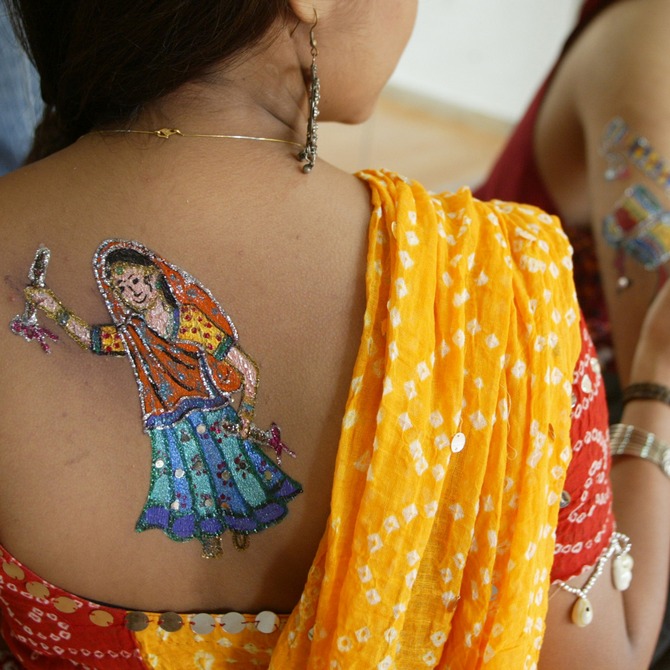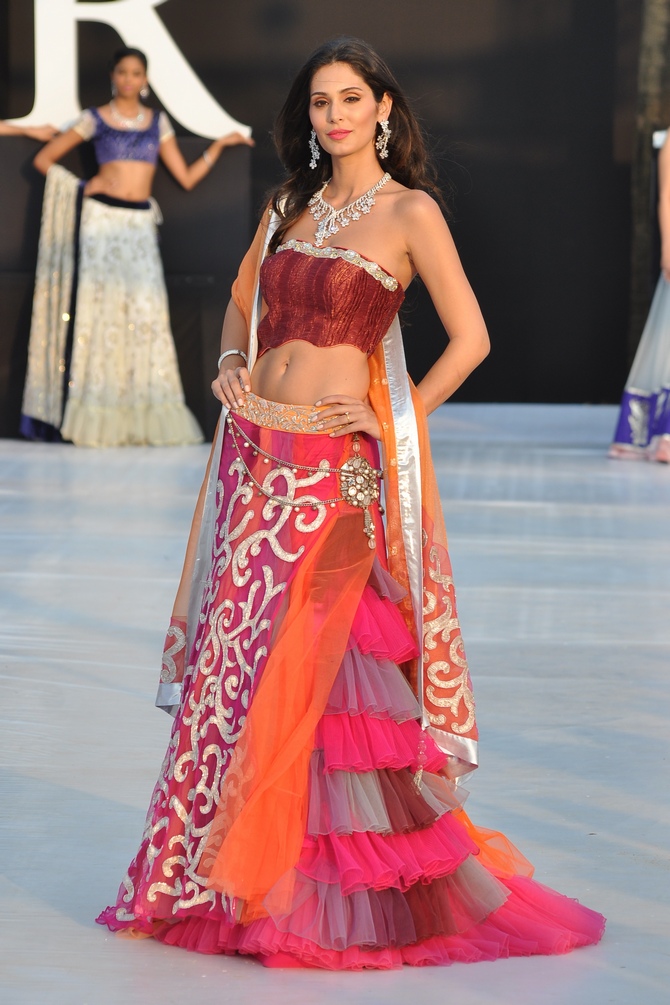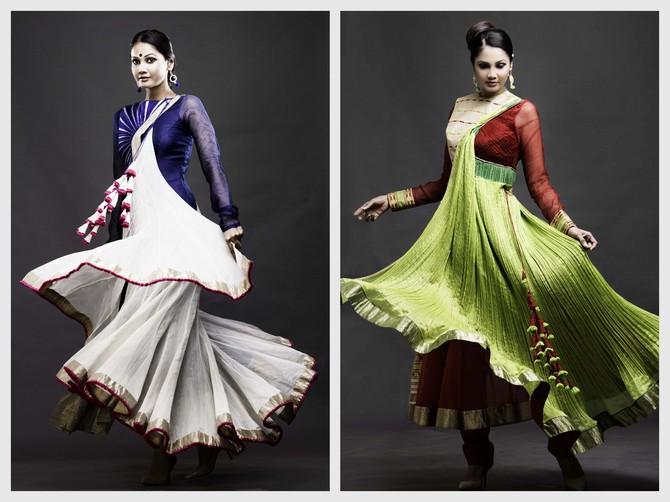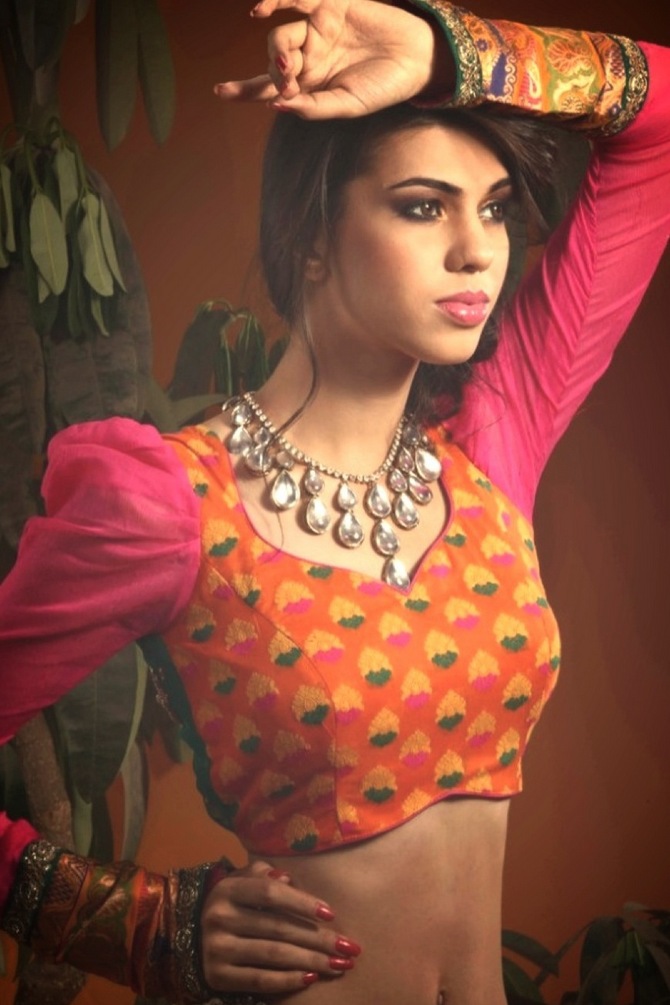
What's hot. What's not. Designers offer fashion trends and tips for this festive season. Abhishek Mande Bhot reports.
Four young Indian designers share the latest Navratri trends and offer handy tips on what you must be seen in this season.
Mumbai-based designer Shouger Merchant Doshi says bright colours are the way to go this season.
"We've seen a distinct shift in our clients' preference for brighter shades," she says. "Earlier you'd have women preferring darker shades of blues and reds and then there was a phase where everyone went on the other side of the spectrum and chose neon. Today the pendulum has settled somewhere at the centre where young women are preferring to be seen in shades of bright pink, yellows, fuchsia etc."
Shades of pink, among other bright colours, are in this season, says Shouger Merchant Doshi.

The procession of kurtas, sporting the anarkali cut, at the last few fashion weeks in India have proved that this style is here to stay.
It has been the one garment that refuses to go off the ramp and has trickled down from high-street and designer stores to the mass markets.
For a festival of tireless dancing, the structure of the garment -- its glorious flare -- makes it a perfect fit. After all, there’s a reason why the anarkali has been named after one of the most famous dancers in India's history.
It isn’t surprising then that Shouger Merchant Doshi recommends the garment to her clients 'to make them stand out'.
"Everyone wears a lehnga. Why not be different and try out the anarkali? The floor-length anarkali can look elegant, dignified, sophisticated and, at the same time, edgy," she says.
Bruna Abdullah walked the runway at India Resort Fashion Week in Goa in a floor-length anarkali for Shouger Merchant Doshi.

No Indian festival can ever be complete without a sari. Yet it is one of the most complicated garments to carry off. Add to that: hours of dancing (and the prospect of carrying a baby if you're a young mother) and you have a problem.
Doshi offers the pre-drape saris as a solution. 'Saris' that are pre-pleated, and come with a waist-band, have been fairly popular amongst young Indian women wanting to try out something new. They are, in many ways, the most apt example of East meeting West. Many of them come with zippers and are most convenient for occasions like Navratri.
"The drapes in a traditional sari tend to make you look broader around the waist. That doesn't happen in a drape sari. You zip it up and you’re good to go,"
Whatever you do choose to wear, sari or anarkali, Doshi suggests matching it with a pair of heels, unless you're going with a short anarkali. In that case a pair of closed shoes would be in order.

Vaishali Shadangule agrees with Doshi. Bright colours are indeed happening at the moment because, she says, it's the easiest way to stand out in a crowd of traditionally-dressed people. "Shades of fuchsia, blue and red are in. Everyone wants something that’s traditional and contemporary at the same time."
So out go the heavy fabrics and bling and in come chanderis and Assam raw silks, called Kesa Paat. This is reflected in Shadangule's latest winter-festive line where the stress has been on ‘keeping it clean yet traditional’.
Like many young designers, Shadangule’s ethnic couture flirts with Western sensibilities. Some of her garments look like gowns, but are not. One of them even sports a pocket! The hemlines are asymmetrical and seem to owe their roots to the traditional anarkali.
"You're going to have to dance a lot. You better find something that flares and flatters your body type and isn't very flashy."
Opt for something light and simple and keep it clean, yet traditional is Vaishali Shadangule's final word of advice.

This Navratri season seems to belong to shades of yellow, lime, aqua and pinks too believes Mrunal Yangad. "Stylish clothing need not be uncomfortable," she offers. Like Shadangule, the Mumbai-based designer recommends light-weight fabrics.
"The kali ghagras or skirts combined with short abla (blouse) and wool-worked cholis will work well. Team it with a net dupatta that has simple borders in bright colours. If you're really feeling ambitious, team up a choli with a fully gathered dhoti salwar or a Gujarati-style draped dupatta," she says.
The key to not ruining your look is to contrast the shades you are wearing, Yangad believes. If you must add bling go for jewellery rather than heavily embroidered blouses. 'You could accessorise heavily and not go wrong at all! That’s the great part about this festival."
Not keen on going completely traditional? Yangad suggests: "Put on your black denims, black tank top and team it with one of your mother's colourful dupatta along with a cummerbund.
Accessorise yourself with three to four neckpieces of varying lengths, a mangtikka, lots of bangles and you are set for dandiya. Mojaris are great but so are gold or silver ballet flats. Oxidised jewellery is a must -- with a pair of large ghungroo payals!"
Short cholis in bright colours will make you stand out adds Mrunal Yangad.

Dhoti salwars aren't just for women says Yangad. Teaming it with a short kurta in black of navy blue and a pastel shade dupatta can work wonders for men too. Yellow, she believes isn’t a taboo for men anymore.
See this: Men in yellow? Why on earth not!
Like may designers for men's clothing, she points out the changing trend: Indian men are much more comfortable carrying off colours than before.
In an earlier interview to Rediff.com, designer Narendra Kumar had pointed to this trend too and it is one that has been reflected in menswear designs over the last few seasons (see this show for instance)
Delhi designer Rajat Suri falls in with that view: “More (Indian) men are embracing the idea of wearing colours that aren’t in shades of black and white.”
The shift hasn’t been as drastic as he’d have liked. Men, are more comfortable with shades of rust, yellow and blue and wouldn’t mind experimenting with pastels and beige etc. But it is a good beginning, he says.
"The waist jacket is an Indian silhouette that is going global. Get yourself one," he suggests, "Perhaps in a bright shade of blue or yellow this season."
Suri, like all other designers, points out: 'it is you who make the clothes look good and not the other way around'.
"Carry a positive attitude. You are more important than clothes. Don't follow trends blindly and avoid going over the top and invest in a pair of good footwear -- flat sandals in jute, canvas or organic fabrics won’t be a bad idea," he says adding “It’s important you really enjoy yourself. Else it isn't worth it."